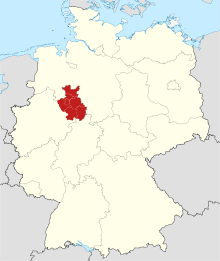Ostwestfalen-Lippe
Ostwestfalen-Lippe ([ˈɔstvɛstˈfaːlənˈlɪpə] (![]()

Many major globally operating companies are headquartered in the region, including Bertelsmann, Miele, Dr. Oetker, Melitta, Gerry Weber, DMG MORI AKTIENGESELLSCHAFT, Hörmann, Schüco, Wincor Nixdorf, Phoenix Contact and Claas. In 2012 OWL became Germans BMBF Leading Edge Technology Cluster for intelligent Technical Systems (it's OWL [1]), which is currently the largest public funded project in the context of the government initiative "Industry 4.0". Universities are located in Bielefeld, Paderborn and Lemgo. The Fraunhofer Society is engaged in OWL in Lemgo and Paderborn.
The Teutoburg Forest stretches across the region. It was the site of the Battle of the Teutoburg Forest in the year 9 AD, where an alliance of Germanic tribes defeated the Roman Empire. In 1875, a statue was unveiled of the commander Arminius, who led the Germans to victory at the battle. This statue, the Hermannsdenkmal, is one of the best-known sights in Ostwestfalen-Lippe.
References
- Web site of Leading Edge Technology cluster it's OWL(Access: 5. May 2014)